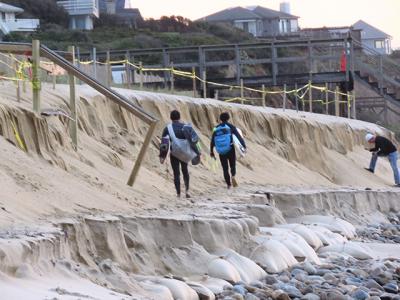Issuing Bonds, Town Moves on Montauk Erosion Control

The East Hampton Town Board agreed last Thursday to issue bonds through which it will spend up to $200,000 for a map, plan, and report, including a cost estimate, of the proposed creation of a beach erosion-control district in downtown Montauk.
The move follows a call last month by the recently formed Montauk Beach Preservation Committee for a feasibility study and engineering analysis for a plan to combat erosion of the hamlet’s ocean beaches. Laura Tooman, the committee’s chairwoman and president of Concerned Citizens of Montauk, had asked that the board provide funding for the initial steps of a project she estimated would cost $15 to $17 million.
Approximately $50,000 will pay for the feasibility study, which would draw potential boundaries of an erosion-control district and explore funding mechanisms, and an additional $100,000 to $150,000 will go to an analysis including beach and inshore surveys, a study of the sediment of potential sand sources, beach replenishment options, and preliminary plans.
The Army Corps of Engineers has indicated that its Fire Island to Montauk Point Reformulation Plan, known as FIMP, would provide significantly fewer cubic yards of sand to replenish Montauk’s ocean beaches than town officials had hoped. Though decades in the making, the plan’s implementation remains several years in the future.
Supervisor Peter Van Scoyoc said at the town board’s Sept. 18 meeting that any federal work “could be offset and bettered by an erosion-control district project.” He said the town must pursue both FIMP and an erosion-control district, given the length of time federal projects take. “We need to have things in place to deal with what we know will be a continual cycle of erosion downtown,” he said.
Also last Thursday, the board authorized a $700,000 bond for the purchase of property at 36 Gann Road at Three Mile Harbor. The money will supplement $1.42 million from the community preservation fund to complete the $2.12-million purchase of the property, where the town is to relocate its shellfish hatchery, which is now at Fort Pond Bay in Montauk.
The new hatchery will be adjacent to the shellfish nursery in Three Mile Harbor and consolidate the town’s aquaculture program, in which waterways are seeded with juvenile clams, scallops, and oysters. The effort is aimed at both restoring shellfish, which were decimated by algal blooms in the 1980s, and promoting healthier waterways, as the bivalves’ filter water.
A small residence on the property will house the town’s Aquaculture Department; other structures are to be removed. The property’s existing sanitary system is to be upgraded, Scott Wilson, the town’s director of land acquisition and management, told the board last month. A permeable reactive barrier, bioswales, and rain gardens may also be installed to intercept nitrogen in groundwater before it reaches the harbor, he said.
The board also authorized a joint request for proposals, with the Town of Southampton, for the “last mile” shuttle service each town is to provide in connection with additional Long Island Rail Road trains that are to begin early next year between Speonk and Montauk.
The additional trains are aimed at alleviating traffic congestion. A key component is the shuttle service through which commuters would get from train stations to their workplaces and back. Two eastbound trains are to be added in the morning, along with one additional westbound train in the afternoon.
Traffic to and from the South Fork, where the so-called trade parade clogs the primary route throughout the year, makes it difficult for employers, including the town, to find qualified employees, Mr. Van Scoyoc said earlier this month.
